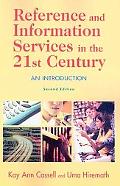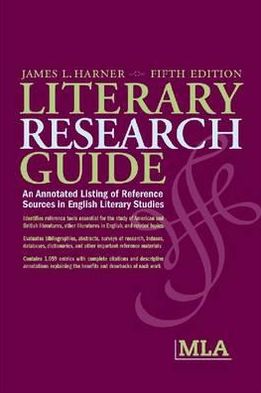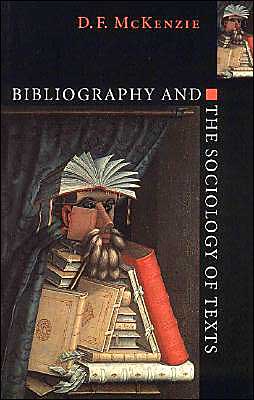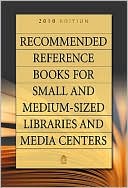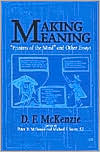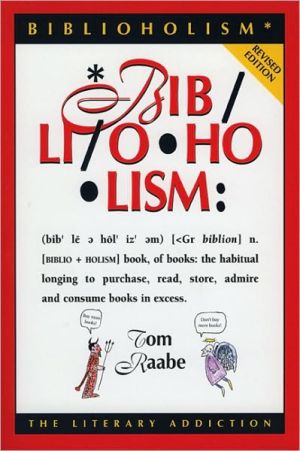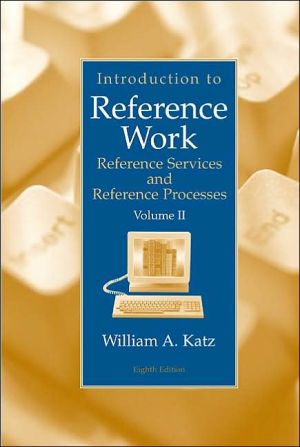Reference and Information Services in the 21st Century
Search in google:
There are over 1,000 reference resources listed in this book. The hybridization of information sources, the multiplication and diversification of reference services, and the sheer exuberance of communicable information make the constant updating of resources an imperative. Readers and practitioners who come upon an interesting new relevant resource, trend, or a change in existing resources not noted by the authors are invited to send in the information to 21reference@gmail.com. Updates, new annotated bibliographies, and any emerging trends will be added to this site biannually in January and August of each year, beginning in January 2010. Doody Review Services Reviewer:Kathryn L Fowler, MLS(Duquesne University)Description:This book is intended to be a reference librarian's guide to answering the question, "Where do I begin to make changes or develop any of the areas under my purview?" The book is broken into four major subject headings with 21 chapters, each concluding with an extensive bibliography. This edition covers similar, if not the same, topics as the 2006 edition, with updated references.Purpose:The authors seek to link their readers to the resources they need to answer the questions they get at the reference desk and within the department.Audience:This book would benefit future librarians in a reference class as well as librarians transferring between disciplines who are not familiar with resources. It also could provide managers and administrators with ideas for rethinking the "it has always been done this way" tendency at their institutions. Both authors have the background and experience to provide with authority an insider's view of the reference department.Features:Each topic is covered in a few pages. Among the topics are locating the best sources for collections, developing staff to use the resources and interact with the public, and finding the answer to the question that the patron perhaps did not articulate. Rather than one index, there are two (subject and reference resources), which makes searching through the book much easier. All of the black-and-white screenshots are clear and include attribution. Assessment:Although the information is relevant, the book only skims each topic. I would have preferred fewer topics covered in more depth, or perhaps the same number of topics in a multiple volume edition. With a larger publication, the needs of the collection, users, management, and librarians could have been covered in more depth, increasing the book's usefulness.
Preface xiAcknowledgments xviiPart I Fundamental Concepts1 Introdution to Reference and Information Services 3Ethical Awareness and Engagement 4Kinds of Information Service 5Selecting and Evaluating Print and Electronic Information 9Creating Finding Tools and Web Sites 10Promoting and Marketing Libraries and Reference Service 11Evaluating Staff and Services 11The Changing Nature of Reference 13Recommendations for Further Reading 13Bibliography of Works Cited in This Chapter 142 Determining the Question: In-person, Telephone, and Virtual Reference Interviews 15Why Conduct the Reference Interview? 15What We Know about the Reference Interview 16Conducting the Reference Interview 17Problematic Strategies in the Reference Interview 22The Telephone Interview 24Virtual Reference-E-mail, Chat, IM, and SMS 25Assessment and Accountability 27RUSA Guidelines-A New, More Integrated Approach 27Understanding and Respecting Cultural Differences 28Improving Our Skills 29A Look Ahead: Striving for Excellent Service 29Recommendations for Further Reading 30Bibliography of Works Cited in This Chapter 313 Finding the Answer: Basic Search Techniques 35Tools of the Answering Trade 36Step 1 Categorize an Answer 36Step 2 Vizualize an Answer 39Step 3 Test the Waters 39Types of Answers 41Common Pitfalls in Reference Answering 44Raison d'etre: Finding the Answers 52Recommendations for Further Reading 53Bibliography of Works Cited in This Chapter 54Part II Introduction to Major Reference Sources4 Answering Questions about Books, Magazines, Newspapers, Libraries and Publishing, and Bibliographic Networks-Bibliographic Resources 57Overview 57Major Bibliographic Resources Used in Reference Work 59Collection Development and Maintenance 67Further Considerations 68Reference Resources Discussed in This Chapter 70Recommendations for Further Reading 72Bibliography of Works Cited in This Chapter 735 Answering Questions about Anything and Everything-Encyclopedias 75Overview 75Major Encyclopedic Resources Used in Reference Work 80Collection Development and Maintenance 92Further Considerations 95Recommended Resources Discussed in This Chapter 97Recommendations for Further Reading 99Bibliography of Works Cited in This Chapter 1006 Answering Questions That Require Handy Facts Ready Reference Sources 103Overview 103Major Ready Reference Resources Used in Reference Work 104Collection Development and Maintenance 116Further Considerations 117Recommended Resources Discussed in This Chapter 119Recommendations for Further Reading 121Bibliography of Works Cited in This Chapter 1227 Answering Questions about Words-Dictionaries 125Overview 125Major Dictionaries Used in Reference Work 127Collection Development and Maintenance 141Further Considerations 143Recommended Resources Discussed in This Chapter 145Recommendations for Further Reading 150Bibliography of Works Cited in This Chapter 1518 Answering Questions about Events and Issues, Past and Present-Indexes and Full-Text Databases 153Overview 153Major Indexes Used in Reference Work 155Collection Development and Maintenance 169Further Considerations 171Final Thoughts 171Recommended Resources Discussed in This Chapter 172Recommendations for Further Reading 177Bibliography of Works Cited in This Chapter 1789 Answering Questions about Health, Law, and Business-Special Guidelines and Sources 179Overview 179Major Health Resources Used in Reference Work 183Major Legal Resources Used in Reference Work 190Major Business Resources Used in Reference Work 194Collection Development and Maintenance 200Further Considerations 203Recommended Resources Discussed in This Chapter 204Recommendations for Further Reading 209Bibliography of Works Cited in This Chapter 21110 Answering Questions about Geography, Countries, and Travel-Atlases, Gazetteers, Maps, Geographic Information Systems, and Travel Guides 213Overview 213Major Geographic Information Resources Used in Reference Work 214Collection Development and Maintenance 223Further Considerations 225Recommended Resources Discussed in This Chapter 226Recommendations for Further Reading 229Bibliography of Works Cited in This Chapter 23011 Answering Questions about the Lives of People-Biographical Information Sources 233Overview 233Major Biographical Resources Used in Reference Work 234Collection Development and Maintenance 242Further Considerations 243Recommended Resources Discussed in This Chapter 245Recommendations for Further Reading 247Bibliography of Works Cited in This Chapter 24812 Answering Questions about Governments-Government Information Sources 249Overview 249Major Government Publication Resources Used in Reference Work 251Collection Development and Maintenance 262Further Considerations 263Recommended Resources Discussed in This Chapter 264Recommendations for Further Reading 266Bibliography of Works Cited in This Chapter 268Part III Special Topics in Reference and Information Work13 When and How to Use the Internet as a Reference Tool 271The Facts 271The Puzzle 271The Solution 272Nature of Internet Reference 273Five Steps to Successful Internet Reference 278Recommendations for Further Reading 287Bibliography of Works Cited in This Chapter 29114 Reader's Advisory Work Mary K. Chelton 293Reader's Advisory and Reference: A Marriage of Convenience 293Common RA Questions 295The Reader's Advisory Interview 296Common Mistakes in the RA Encounter 298Reader's Advisory Reference Tools 300The Top Ten RA Tools 301Keeping Current 304Bibliography of Works Cited in This Chapter 30515 Reference Work with Children and Young Adults Mary K. Chelton 307Introduction: Challenges of Working with Young Audiences 307Special Topics in Reference and Information Work with Youth 308Research and Assignment Topics 311Solutions to Common Problems in Reference Work with Youth 311Reader's Advisory Questions in Youth Reference Services 315Conclusion 315Bibliography of Works Cited in This Chapter 31516 Information Literacy in the Reference Department 319Standards for Information Literacy 320Approaches to Information Literacy 321Information Literacy by Type of Library 322Social and Ethical Uses of Information 323One-on-One Instruction 324Information Literacy in a Classroom Setting 326Impact of New Technology on the Teaching of Information Literacy 327Assessment and Evaluation of Information Literacy 328Information-Seeking Behavior 329Further Considerations 329Recommendations for Further Reading 330Bibliography of Works Cited in This Chapter 333Part IV Developing and Managing Reference Collections and Services17 Selecting and Evaluating Reference Materials 337Identifying, Selecting, and Evaluating New Reference Materials 339Management of the Reference Budget 344Ongoing Assessment of Reference Collections 344Writing a Reference Collection Development Policy 346Promoting and Marketing Reference Materials to Library Users 348Recommendations for Further Reading 348Resources Discussed in This Chapter 349Bibliography of Works Cited in This Chapter 35018 Managing Reference Departments 351Of Car Designs and Learning Styles 351Organizing Reference Departments 352Organizing Staff 353Management of Service Delivery 354New Roles 357Further Considerations 360Recommendations for Further Reading 361Bibliography of Works Cited in This Chapter 36319 Assessing and Improving Reference Services 367Why Assess 367What to Assess 368How to Assess 369Acting on Assessments 382Ongoing Assessments: An Imperative 384Recommendations for Further Reading 385Bibliography of Works Cited in This Chapter 38720 Reference 2.0 389Changing Vocabulary Attests to Changing Times 389What Is the 2.0 Universe? 390Cooperative Content Creation 391Social Networking 402Customization 404Seamlessness 408Concluding Remarks: The Tree of 2.0 Knowledge 412Recommendations for Further Reading 413Bibliography of Works Cited in This Chapter 41521 The Future of Information Service 419New Ways of Doing Business-Reference 2.0 420Providing New Materials and Formats 421Providing New Service Models 422What Will Librarians Do? Competencies Needed 423Planning the Future 425What Will the Future of Reference Look Like? 426Does Reference Have a Future? 426Recommendations for Future Reading 427Bibliography of Works Cited in This Chapter 428Appendix: RUSA Outstanding Reference Sources 2005-2009 431Subject Index 435Index of Reference Resources Described 447About the Authors 461
